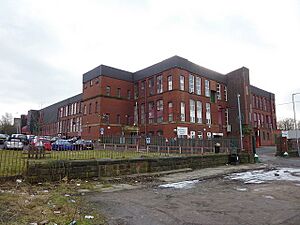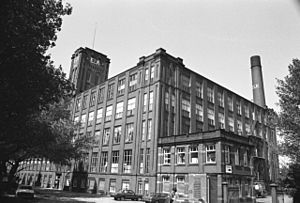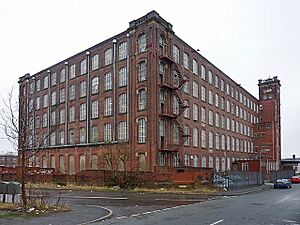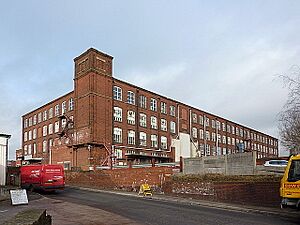List of mills in Royton facts for kids
Royton, a town in Greater Manchester, England, was once a very important place for making cotton. During the Industrial Revolution, many large factories called cotton mills were built here. These mills used machines to spin raw cotton into thread and weave it into fabric. This list tells you about the different cotton mills that existed in Royton. They played a huge part in the town's history and economy.
Contents
Mills from A to E
- Bee Mill: This mill was built in 1901 on Shaw Road. It had many spinning machines, over 100,000 of them! It closed in 1964, but the building is still standing today.
- Beech Mill: Located on Chapel Street, this mill was active before 1838. It had about 55,000 spinning machines. It stopped working in 1917.
- Belgian Mill: Built around 1862 on Blackshaw Lane, this mill had over 61,000 spinning machines. It closed in 1931 and was gone by 1955.
- Birchinlee Mill: This mill was on Middleton Road and was built before 1845. It closed in 1993.
- Delta Mill: Built in 1902 on Crompton Street, Delta Mill was a very large factory. By 1954, it had nearly 125,000 spinning machines! It was extended in 1913. From 1950 to 1979, a company called Cotton & Rayon Spinners Ltd used it. Later, parts of the mill were removed. Today, a company called Crane Payment Innovations uses the building.
- Dogford Mill: This was an early mill, built around 1795 on Low Crompton Road. It used water power and a small steam engine. It was gone by 1871.
- Downey Mill: Located on Mill Street, this mill was active before 1838 and closed in the 1920s. It was gone by 1939.
- Elk Mill: Built in 1927 on Broadway, Elk Mill was one of the last mills built in Lancashire during a tough economic time. It was huge, with over 107,000 spinning machines! It used a powerful steam turbine engine. The mill closed in 1998 and was demolished in 1999. Now, a shopping center called Elk Mill Retail Park stands where it used to be.
- Elly Clough Mill: This mill on Holden Fold Lane was active before 1817. It used water power and a small steam engine. It was gone by the 1930s.
Mills from F to J
- Fields / Lees Hall Mill: Located on Holden Fold Lane, this mill used a 7-horsepower steam engine. It was active before 1817 and was gone by around 1950.
- Fir Mill: Built in 1906 on Highbarn Street, Fir Mill had over 107,000 spinning machines. It closed in 1959. The building is still standing today and is known as Vernon Works.
- Grape Mill: This mill was built in 1906 on Crompton Street. It was a very large mill with over 126,000 spinning machines. It used a powerful 1600-horsepower engine. Grape Mill is still standing today.
- Gravel Hole Mill: Built around 1870 on Springfield Lane, this mill had 90 looms (machines for weaving fabric) by 1954. It closed in 1959.
- Hall Street / Top of the Fold Mill: This early mill was built between 1776 and 1778 on Fleet Street. By 1889, it had over 55,000 spinning machines. It was gone by around 1900.
- Holden Fold / Strange Mill: Built in 1832 on Holden Fold Lane, this mill had 10,000 spinning machines and 346 looms by 1889. It is still standing today.
- Holly Mill: This mill was built in 1890 on Flake Lane. It grew to have over 142,000 spinning machines by 1905. It closed and was demolished in 1957.
- Industry Mill: Built in 1875 on Industry Street, this mill had over 77,000 spinning machines by 1887. It closed in 1927 and was gone by the 1930s.
Mills from K to O
- King Mill: Built in 1897 on Crompton Street (now Shaw Road), King Mill was a very busy place. By 1915, it had over 75,000 mule spinning machines and 277,000 ring spinning machines! It closed in 1959 and was demolished in 1982.
- Lion Mill: This impressive mill was built in 1890 on Fitton Street. It had over 109,000 spinning machines and a powerful 2000-horsepower engine. Lion Mill is known for its strong, fireproof design and its tall, decorative tower. It closed in 1967 but is still standing today.
- Luzley Brook / Albion Mill: This was a water-powered mill on Crompton Street (now Shaw Road). It was active before 1776 and was gone by 1891.
- Monarch Mill: Built in 1903 on Jones Street, Monarch Mill had over 132,000 spinning machines. It closed in 1972 and was demolished in 2005.
- Moss / Lamb / Rhos Mill: This mill on Higginshaw Lane was built in 1862. By 1915, it had over 24,000 mule spinning machines and 10,000 ring spinning machines. It was gone by 1975.
- Norman Mill: Built in 1887 on Boundary Street, Norman Mill had over 50,000 spinning machines by 1915. It closed in 1931.
Mills from P to T
- Park and Sandy No.1 Mill: This mill on Sandy Lane was built around 1850 or 1875. By 1889, it had over 35,000 spinning machines. It closed in 1949 and was gone by the 1960s.
- Park and Sandy No.2 Mill: Built in 1913 on Schofield Street, this mill had 100,000 spinning machines by 1915. It closed in 1977 and was demolished in 2005.
- Park Lane / Vinegar Mill: This mill on Park Lane was active around 1844.
- Park No.1 / Highfield Mill: Built in 1876 on Bleasdale Street, this was a very large mill with 250,000 spinning machines by 1915! It closed in 1962 and was demolished in 1989.
- Park No.2 Mill: Built in 1912 on Bleasdale Street, this mill had 100,000 spinning machines by 1915. Its chimney was famously taken down by Fred Dibnah, a well-known steeplejack, just before he passed away. The mill was demolished in 2004.
- Parkside No.1 Mill: Built in 1872 on Edge Lane Street, this mill grew to have over 143,000 spinning machines by 1915. It closed in 1928 and was gone by the 1930s.
- Parkside No. 2 Mill: Built in 1891 on Edge Lane Street, this mill also had over 143,000 spinning machines by 1915. It closed in 1981 and was demolished in 1983.
- Roy Mill: Built in 1906 on Rochdale Road, Roy Mill had 140,000 spinning machines by 1915. It closed in 1981 and was demolished in 1984.
- Royton Mill: This mill on Mill Lane was active before 1891 and was gone by around 1900.
- Royton Lane / Lane End Mill: Active before 1817 on Royton Lane (now Middleton Road), this mill had 120 looms by 1923. It used a steam engine, which was later replaced by an oil engine. This building is still standing today and is known as Charlton House.
- Royton Ring Mill: Built in 1908 on Industry Street (now St. Phillips Drive), this mill had over 64,000 ring spinning machines and 6,400 doubling machines by 1915. It closed in 1966 and was demolished in 1992.
- Royton Spinning No.1 Mill: Built in 1872 on High Barn Street, this mill had over 68,000 spinning machines by 1915. It closed in 1958 and was demolished in 1961.
- Royton Spinning No.2 Mill: Built in 1883 on High Barn Street, this mill also had over 68,000 spinning machines by 1915. It closed in 1958 and was demolished in 1961.
- Sandy Lane Mill: This mill on Sandy Lane was active before 1832.
- Seville's Mill: Also on Sandy Lane, this mill was replaced by Park and Sandy No. 1 Mill before 1850.
- Shiloh Mill: This early mill on Holden Fold Lane was built in 1789 but unfortunately burnt down by 1870.
- Shiloh No.1 Mill: Built in 1876 on Holden Fold Lane, this mill had over 26,000 spinning machines. It closed in 1953 and was demolished in 1957.
- Shiloh No.1A Mill: Built in 1888 on Holden Fold Lane, this mill had over 9,000 spinning machines. It closed in 1953 and was demolished in 1957.
- Shiloh No.2 Mill: Built between 1899 and 1901 on Holden Fold Lane, this mill had over 74,000 spinning machines. It closed in 1959 and was demolished in 1976.
- Spaw / Spa / Owler Mill: This mill on Mill Lane was active before 1838. It was extended in 1866 and closed in 1959.
- Springfield Mill: Built in 1869 on Moss Lane, this mill had 74,000 mule spinning machines by 1915. It burnt down, closed in 1954, and was gone by 1962.
- Springhill Mill: This mill on Middleton Road was built around 1830. By 1889, it had 40,000 spinning machines and 527 looms. It was gone by 1930.
- Star Mill: Built in 1874 on Edge Lane Street, Star Mill had over 106,000 spinning machines by 1915. It closed and was demolished in 1929.
- Thornham No.1 Mill: Built in 1874 on Oozewood Road, this mill had over 85,000 mule spinning machines by 1915. It closed and was demolished in 1962.
- Thornham No.2 Mill: Built in 1885 on Oozewood Road, this mill also had over 85,000 mule spinning machines by 1915. This mill is still standing today.
- Thorp Mill: This was a very early mill, built in 1764 on Thorp Clough. It closed in 1788.
- Travis Mill: This mill on Holden Fold Lane was active before 1838 and had 140 looms by 1889. It was replaced by Shiloh No.2 Mill by 1897.
- Turf Lane Mill: Built in 1874 on Turf Lane, this mill had over 115,000 mule spinning machines and 14,000 ring spinning machines by 1915. It closed in 1930 and was gone by the 1960s.
Mills from U to Z
- Union Mill: This mill on Union Street was active before 1827. By 1889, it had 24,000 spinning machines and 600 looms. It closed in 1896.
- Vine Mill: Built in 1897 on Middleton Road, Vine Mill had over 97,000 spinning machines by 1915. It is still standing today.
- Woodstock New Mill: Built in 1884 on Meek Street, this mill had over 93,000 spinning machines by 1915. It closed in 1934.
- Woodstock Old Mill: Also on Meek Street, this mill was built in 1873. It closed in 1934 and was gone by 1939.
Images for kids

All content from Kiddle encyclopedia articles (including the article images and facts) can be freely used under Attribution-ShareAlike license, unless stated otherwise. Cite this article:
List of mills in Royton Facts for Kids. Kiddle Encyclopedia.












